
Errol Leslie Thomson Flynn was an Australian-American actor who achieved worldwide fame during the Golden Age of Hollywood. He was known for his romantic swashbuckler roles, frequent partnerships with Olivia de Havilland, and reputation for his womanising and hedonistic personal life. His most notable roles include Robin Hood in The Adventures of Robin Hood (1938), which was later named by the American Film Institute as the 18th greatest hero in American film history, the lead role in Captain Blood (1935), Major Geoffrey Vickers in The Charge of the Light Brigade (1936), and the hero in a number of Westerns such as Dodge City (1939), Santa Fe Trail (1940), and San Antonio (1945).

Margaret Alexis Fitzsimmons-Smith was a Canadian-born American actress and singer. She appeared in several major Hollywood films in the 1940s and had a notable career on Broadway in the 1970s, winning a Tony Award in 1972 for the Stephen Sondheim-James Goldman musical Follies.

David Bruce was an American film actor. He was a company member of Peninsula Players Theatre in Fish Creek, Wisconsin in 1939.
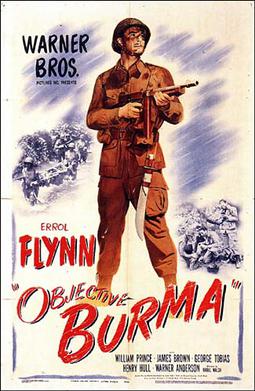
Objective, Burma! is a 1945 American war film that is loosely based on the six-month raid by Merrill's Marauders in the Burma Campaign during the Second World War. Directed by Raoul Walsh and starring Errol Flynn, the film was made by Warner Bros. immediately after the raid.

Santa Fe Trail is a 1940 American Western film directed by Michael Curtiz and starring Errol Flynn as J. E. B. "Jeb" Stuart, Olivia de Havilland, Raymond Massey as John Brown, Ronald Reagan as George Armstrong Custer and Alan Hale. Written by Robert Buckner, the film is critical of the abolitionist John Brown and his controversial campaign against slavery before the American Civil War. In a subplot, Jeb Stuart and George Armstrong Custer—who are depicted as friends from the same West Point graduating class—compete for the hand of Kit Carson Holliday.

They Died with Their Boots On is a 1941 American Biographical western film from Warner Bros. Pictures, produced by Hal B. Wallis and Robert Fellows, directed by Raoul Walsh, that stars Errol Flynn and Olivia de Havilland.

Four's a Crowd is a 1938 American romantic comedy film directed by Michael Curtiz, starring Errol Flynn, Olivia de Havilland, Rosalind Russell and Patric Knowles. The picture was written by Casey Robinson and Sig Herzig from a story by Wallace Sullivan. This was the fourth of nine films in which Errol Flynn and Olivia de Havilland appeared.
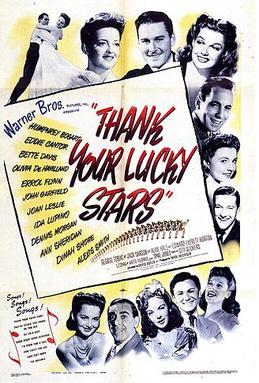
Thank Your Lucky Stars is a 1943 American musical comedy film made by Warner Brothers as a World War II fundraiser, with a slim plot involving theater producers. The stars donated their salaries to the Hollywood Canteen, which was founded by John Garfield and Bette Davis, who appear in this film. It was directed by David Butler and stars Eddie Cantor, Dennis Morgan, Joan Leslie, Edward Everett Horton and S.Z. Sakall.
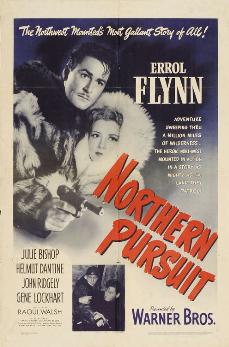
Northern Pursuit is a 1943 American World War II film directed by Raoul Walsh and starring Errol Flynn as a member of the Royal Canadian Mounted Police (RCMP) who tries to uncover a Nazi plot against the Allied war effort. The film was set in Canada during the early years of the war.

Gentleman Jim is a 1942 film directed by Raoul Walsh and starring Errol Flynn as heavyweight boxing champion James J. Corbett (1866–1933). The supporting cast includes Alexis Smith, Jack Carson, Alan Hale, William Frawley, and Ward Bond as John L. Sullivan. The movie was based upon Corbett's 1894 autobiography, The Roar of the Crowd. The role was one of Flynn's favorites.

Adventures of Don Juan is a 1948 American Technicolor swashbuckling adventure romance film directed by Vincent Sherman and starring Errol Flynn and Viveca Lindfors, with Robert Douglas, Alan Hale, Ann Rutherford, and Robert Warwick. Also in the cast are Barbara Bates, Raymond Burr, and Mary Stuart. The film was distributed by Warner Bros. and produced by Jerry Wald. The screenplay by George Oppenheimer and Harry Kurnitz, based on a story by Herbert Dalmas, has uncredited contributions by William Faulkner and Robert Florey.
Hollywood Daffy is a 1946 Warner Bros. Merrie Melodies cartoon, starring Daffy Duck. The cartoon was written by Michael Maltese and was released on June 22, 1946.
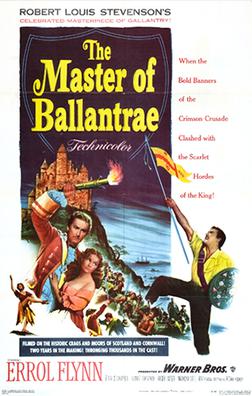
The Master of Ballantrae is a 1953 British Technicolor adventure film starring Errol Flynn and Roger Livesey. It is a loose and highly truncated adaptation of the Robert Louis Stevenson 1889 novel of the same name. In eighteenth century Scotland, two sons of a laird clash over the family estate and a lady.

Rocky Mountain is a 1950 American Western film directed by William Keighley and starring Errol Flynn. It also stars Patrice Wymore, who married Flynn in 1950. The film is set in California near the end of the American Civil War.

Never Say Goodbye is a 1946 American romantic comedy film directed by James V. Kern and starring Errol Flynn, Eleanor Parker and Lucile Watson. Produced and distributed by Warner Brothers, it is about a divorced couple and the daughter who works to bring them back together. It was Errol Flynn's first purely comedic role since Footsteps in the Dark.

Dive Bomber is a 1941 American aviation film from Warner Bros. Pictures, directed by Michael Curtiz, and starring Errol Flynn and Fred MacMurray. The film is notable for both its Technicolor photography of pre-World War II United States Navy aircraft and as a historical document of the U.S. in 1941. This includes the aircraft carrier USS Enterprise, one of the best-known U.S. warships of World War II.
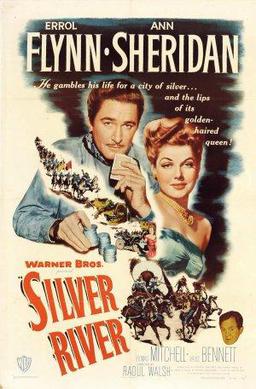
Silver River is a 1948 American western film directed by Raoul Walsh and starring Errol Flynn, Ann Sheridan and Thomas Mitchell. The film is based on a Stephen Longstreet story that was turned into a novel. It was produced and distributed by Warner Bros..

Adventures of Captain Fabian or Adventure in New Orleans is a 1951 American adventure film directed by William Marshall and starring Errol Flynn, Micheline Presle, Vincent Price, Agnes Moorehead and Victor Francen.
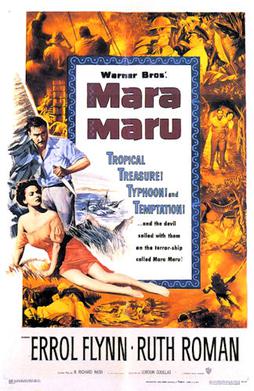
Mara Maru is a 1952 American noir action film directed by Gordon Douglas and starring Errol Flynn, Ruth Roman and Raymond Burr.

Montana is a 1950 American Western film directed by Ray Enright and starring Errol Flynn. It was only the second time Flynn played an Australian on screen, the first time being Desperate Journey (1942).


















